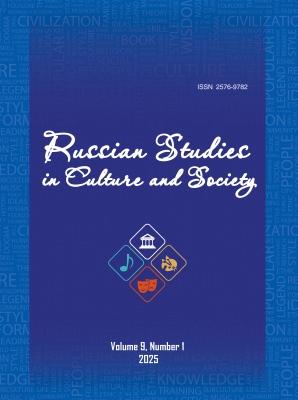GENERATIVE DESIGN IN CULTURAL FLUX: SPATIOTEMPORAL DYNAMICS AND VALUE METRICS
Аннотация
Culture, as the core dimension for value manifestation in generative design, exerts decisive influence on design morphology through its spatiotemporal attributes and structural characteristics. Within contemporary cultural contexts, generative design exhibits dynamic volatility: temporally, it manifests as a dialectical unity between functional iteration and spiritual inheritance; spatially, it forms an interplay between the embeddedness of local cultures and the perceptibility of globalization; and systemically, it confronts the evolutionary challenge of transitioning from static to dynamic paradigms in image dissemination during the internet era. This study aims to construct a culturally driven value assessment system for generative design, focusing on two core objectives: first, breaking down semantic exchange barriers between professional and non-professional groups, and second, establishing a quantifiable measurement model for generative design’s value dimensions. Under the theoretical framework of cultural volatility, a mixed-methods approach is adopted: Cultural Element Deconstruction: Applying grounded theory to decode design samples, building analytical models for temporal volatility, spatial volatility, and internal-external volatility; Value Matrix Construction. The study found that: 1) cultural volatility drives design evolution through the ‘function-spirit’ double helix structure; 2) the cultural adaptability of generative design in the spatial dimension verifies the dynamic balance mechanism between localisation and globalisation. This research advances a systematic methodology for evaluating generative design’s cultural value, offering insights for balancing technological innovation with cultural sustainability in AI-augmented design ecosystems.
EDN: QJGVCA
Литература
A product design based on interaction design and axiomatic design theory / R. Lu [et al.] // Procedia CIRP. 2016. Vol. 53. P. 125-129.
Zhao X. Application of 3D CAD in landscape architecture design and optimization of hierarchical details // Computer-Aided Design and Applications. 2020. Vol. 18. № S1. P. 120-132. https://doi.org/10.14733/cadaps.2021.s1.120-132
Kahn J.S. Culture: demise or resurrection? // Critique of Anthropology. 1989. Vol. 9. № 2. P. 5-25. https://doi.org/10.1177/0308275X8900900202
Schwartz N.B. Villainous cowboys and backward peasants: popular culture and development concepts // The Journal of Popular Culture. 2010. Vol. XV. № 4. P. 105-113. https://doi.org/10.1111/j.0022-3840.1982.1504_105.x
Mehaffy M. W. Generative methods in urban design: a progress assessment // Journal of Urbanism International Research on Placemaking & Urban Sustainability. 2008. Vol. 1. № 1. P. 57-75. https://doi.org/10.1080/17549170801903678
Asakawa K. Flow experience, culture, and well-being: how do autotelic japanese college students feel, behave, and think in their daily lives? // Journal of Happiness Studies. 2010. Vol. 11. № 2. P. 205-223. https://doi.org/10.1007/s10902-008-9132-3
Chandler L. Immersed in design: using an immersive teaching space to visualise design solutions / L. Chandler, A. Ward // International Journal of Art & Design Education. 2019. Vol. 38. № 2. P. 314-327. https://doi.org/10.1111/jade.12191
Tonucci J. Schmid, christian (2022): henri lefebvre and the theory of the production of space // Raumforschung und Raumordnung. 2024. Vol. 82. № 5. P. 445-447. https://doi.org/10.14512/rur.2248
Imhoof D. Beyond no future: cultures of german punk ed. by mirko M. Hall, seth howes, and cyrus shahan (review) / D. Imhoof // German Studies Review. 2018. Vol. 41. № 1. P. 218-220. https://doi.org/10.1353/gsr.2018.0038
Biloshapka V. The value matrix: a tool for assessing the future of a business model / V. Biloshapka, O. Osiyevskyy, M. Meyer // Strategy & Leadership. 2016. Vol. 44. № 4. P. 41-48. https://doi.org/10.1108/SL-04-2016-0026
Ackley D.H. A learning algorithm for boltzmann machines / D.H. Ackley, G.E. Hinton, T.J. Sejnowski // Cognitive Science. 1985. Vol. 9. № 1. P. 147-169. https://doi.org/10.1016/S0364-0213(85)80012-4
Kemper J. Glitch, the post-digital aesthetic of failure and twenty-first-century media // European Journal of Cultural Studies. 2023. Vol. 26. № 1. P. 47-63. https://doi.org/10.1177/13675494211060537
Breaking from realism: exploring the potential of glitch in AI-generated dance / B. Wallace [et al.] // Digital Creativity. 2024. Vol. 35. № 2. P. 125-142. https://doi.org/10.1080/14626268.2024.2327006
Pilkington O.A. The fictionalized reader in popular science: reader engagement with the scientific community // Text & Talk. 2018. Vol. 38. № 6. P. 753-773. https://doi.org/10.1515/text-2018-0022
Why are antagonistic web-generated artworks more popular than human artists? / Zhang Xianyang [et al.] // Robotics Industry. 2017. Vol. 15. № 4. P. 36-39.
Strathern A. Strange parallels: southeast Asia in global context, c. 800–1830. Volume 2: mainland mirrors: europe, japan, china, south Asia, and the islands // Journal of Global History. 2012. Vol. 7. № 1. P. 129-142. https://doi.org/10.1017/S1740022811000611
Copyright (c) 2025 Wei Weng

Это произведение доступно по лицензии Creative Commons «Attribution-NonCommercial-NoDerivatives» («Атрибуция — Некоммерческое использование — Без производных произведений») 4.0 Всемирная.


























